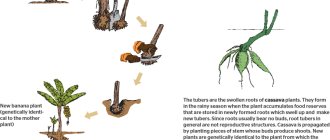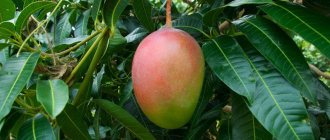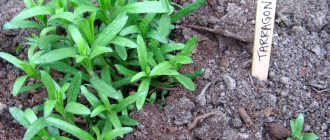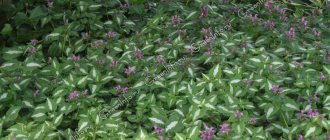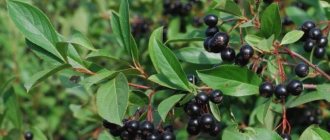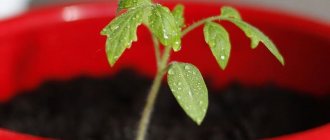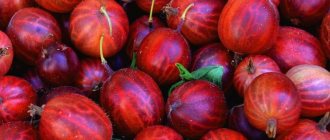The common gooseberry (Ribes uva-crispa), either European or rejected, is a member of the currant genus of the gooseberry family. The birthplace of this plant is considered to be Western Europe and North Africa. Under natural conditions, it is still found in Southern and Central Europe, Central Asia, the Caucasus and North America. J. Ruel was the first to describe gooseberries in 1536 in the book “De natura stirpium”. The existence of gooseberries in European countries became known only in the 16th century, while in the 17th century in England its popularity increased sharply, as a result, breeders began intensive work to develop new varieties of this crop. At first, only a few varieties of gooseberries were obtained, but by the 19th century there were already several hundred of them. Specialists from America also worked on gooseberries; they obtained a hybrid of this plant that is resistant to powdery mildew, which is considered the main enemy of this crop. Today, gooseberries are cultivated in almost every country. In Russia, such a plant is called “northern grapes”.
Selection of planting material
Seedlings are selected from standard varietal plants. You will learn about the best gooseberry varieties for growing in this article.
In order for young gooseberries to take root, the following requirements are taken into account:
- the root system must have at least 3 skeletal roots 20-25 cm long;
- the above-ground part should contain 2-3 strong branches measuring about 30 cm;
- seedlings are selected without mechanical damage.
Plants with an open root system are taken without leaves (except for the top), and bushes with a closed root system, on the contrary, are taken leafy.
How to prune?
We prune gooseberry bushes in order to give the plants the correct shape. In addition, proper pruning will protect the bush from thickening and will contribute to a bountiful harvest. You may be surprised, but even a newly purchased bush, consisting of only 3-4 branches, should be pruned! On each of them you need to leave 2-4 buds, and the rest can be safely removed. Don’t worry, next year the bush will grow rapidly and, perhaps, will already produce its first harvest!
In the spring of next year, as soon as branches from the roots begin to grow from the ground, we leave 3-4 of them and remove the rest. We choose only powerful, well-developed shoots. Their tops will need to be cut off so that side branches appear. However, for varieties with a high degree of branching, this procedure does not need to be done: everything will work out by itself. Remember that the degree of shortening of the shoots should correspond to the degree of their development. The basic rule: the more branching, the more moderate the pruning.
If you stick a branch into the drainage hole of the pot in the spring, then by autumn you will have a new plant
Do you want your gooseberries to be larger? Then in the summer, do additional pruning of green shoots, leaving no more than six leaves and one berry in each tassel. This simple technique allows you to obtain gooseberry fruits of a much larger size than usual.
Autumn planting
Autumn is a favorable time for planting. Over the winter the shrub will take root well and take root.
Optimal timing
Gooseberries are planted in late September - mid-October (depending on the climate). The event is held a month before the first sub-zero temperatures. The roots begin to go deeper into the soil at daytime temperatures of + 10...+15 C. In case of premature frosts, planting is postponed until spring, since the plant will not have time to take root and will freeze out.
Soil preparation
The shrub loves fertile, loose soil in well-lit, ventilated areas, but does not tolerate waterlogging. Therefore, it is not planted in wetlands and close to groundwater.
Gooseberry bushes prefer neutral or slightly acidic soil. If the soil is acidic, add limestone or dolomite flour. Before planting, the area is dug up and cleared of weeds.
You can determine the increased acidity of the soil as follows: if moss, sorrel, and horsetail grow on the site, the acidity is high.
In order for the soil to settle, holes are dug 2-3 weeks before planting. The optimal depth is 50-55 cm, width is 55-60 cm. The holes are filled 2/3 with fertilizers (superphosphate, ash, rotted manure).
Step-by-step recommendations for planting
Autumn planting of gooseberries is carried out in several steps:
- Inspect the bush for damage, remove unhealthy parts and broken roots with pruning shears.
- The plant is placed to a depth of no more than 5 cm at the root collar.
- Sprinkle the roots with soil so that there are no voids between them.
- Compact the soil with your feet (not too much) to secure the bush to the soil surface.
- The tree trunk circle is watered with 5 liters of water.
- Mulch the soil with peat or humus.
The seedlings are watered once every 4-5 days (if there is no rain).
10 days after planting, gardeners recommend treating the bushes against pests and fungi for prevention. In autumn, seedlings are not pruned.
In this video, the gardener shares his experience of planting gooseberries in the autumn:
Do I need to insulate for winter?
Gooseberries are a frost-resistant crop. Adult plants are not specially covered for the winter; snow cover is sufficient to retain heat. Seedlings, especially in regions where winters are cold, protect against freezing. Plants are covered with spruce branches, fallen leaves or agrofibre.
Gooseberry pests and their control
In some cases, pests may settle on the shrub, with the gooseberry moth and shoot aphids most often damaging the plant. Before the gooseberries bloom, a moth emerges from the ground. She lays eggs in the flowers of the plant. When flowering comes to an end, rich green caterpillars emerge from the eggs, they gnaw at the berries and eat the seeds. If an aphid settles on a bush, the leaf plates will begin to curl, the stems will thin out and become crooked, their growth will stop, and unripe fruits will also shrink and fall off. To get rid of these pests, the bush needs to be sprayed with Fufanon or Actellik. However, as you know, it is easier to prevent pests from infesting a bush than to get rid of them later. Therefore, the following preventive measures should be carried out regularly:
- After all the snow has melted, the surface of the soil under the plants must be covered with very dense material (for example, roofing felt), while its edges are sprinkled with soil. As a result, moths will not be able to get out of the ground. When the bush fades, this shelter must be removed.
- In autumn, the bush needs to be hilled to a height of ten centimeters.
- It is necessary to systematically collect and destroy fruits that contain caterpillars.
- Faded bushes should be treated with Lepidocide or Bicol.
Protecting gooseberries from gooseberry moth caterpillars. Website "Garden World"
Spring planting
In spring, gooseberries are planted before sap flow begins. If you neglect the deadlines, you may not wait for a bountiful harvest, the bush will grow weak.
Optimal timing
The favorable time for planting in spring depends on the region. In warm regions, gooseberries are planted in March, in the northern regions - until the end of April. Plant until the buds swell.
Soil preparation
It is better to fertilize the soil in the fall. In spring, it is difficult to apply fertilizers due to high soil moisture. The choice of planting site and soil acidity are no different from planting in the fall.
Gooseberries are not planted where raspberries, other varieties of gooseberries, and currants used to grow, since these plants are affected by common diseases and pests. Places where peas, potatoes, and beets grew are considered favorable for planting.
Step-by-step recommendations for planting
Spring planting of seedlings consists of the following steps:
- Seedlings are inspected for damage. Sick, dry, rotten roots are removed.
- The bushes are treated with a biostimulant solution (Zircon, Epin). This way the root system will take root better.
- In order for the root shoots to grow faster and take root, the plant is placed in the hole at an angle of 45 degrees.
- The soil around the seedling is compacted (not tightly) and watered with water.
- Aboveground shoots are cut to 15-20 cm, leaving 3-4 buds.
After planting, the bushes are watered once a week (until the roots are established). The tree trunk circle is regularly weeded. To protect against weeds, the soil is mulched with peat and leaves.
Watch the following video on how to plant gooseberries in spring:
When and what to feed?
In the spring and summer (from bud break to the end of shoot growth), gooseberry bushes need feeding. The need for nitrogen is especially great at this time. In the second half of summer and until late autumn, plants need more phosphorus and potassium.
Good results are obtained by fertilizing with solutions of bird droppings, mullein, slurry or mineral fertilizers. To prepare mineral fertilizer, take 30-50 g of ammonium nitrate, 50-80 g of superphosphate and 20-30 g of potassium salt in a bucket of water. We feed the plants once during the formation of the ovary.
Various ways to grow gooseberries
In addition to the usual bush formation, gooseberries are grown on a trunk and on a trellis. Let's consider these agricultural methods.
On the trellis
Growing berry bushes on a trellis has its advantages:
- evenly spaced branches of the bush increase illumination, which contributes to the smooth ripening of berries;
- vertical planting has a positive effect on the quality of the crop: the fruits grow large and sweet;
- bushes become less dirty and become infected with fungal infections.
Trellis - reinforced concrete, wooden, plastic pillars (pipes) about 2 m in size are placed on both sides of the row. Wire is stretched between the pillars at 3 levels. Several bushes (5-6) are planted at a distance of 0.5 to 1 m from each other, the branches are arranged in the shape of a fan. The plant is then tied to the bottom wire of the structure and directed vertically. Seedlings are pruned to 3-4 buds.
The shoots that have grown from the root collar are removed in the second year to form the shoot wall thickness and density. The lateral growths grown on the main bushes are shortened above the 5th leaf.
They care for the shrub as with normal planting: mulch, water, and trim. Fertilizers are applied in the spring.
Gooseberry without thorns
Breeders have developed thornless gooseberry varieties, which are in great demand among gardeners. These varieties are distinguished by early and rich fruiting. A good harvest is harvested in the second year after planting, and an adult shrub produces up to 1.5 kg of fruit.
The thornless gooseberry loves fertile soils. In the fall they fertilize with organic compounds, and in the spring with ammonium nitrate or urea.
The peculiarity of these varieties is that the bushes do not pollinate well, so they are planted at a distance of at least a meter from each other. Otherwise, planting and pruning plants is no different from other varieties.
Growing standard gooseberries
Gooseberry bushes arranged in a standard way not only serve as decoration for the garden, but also have their own advantages:
- the plant receives more light, due to which the berries ripen evenly and grow large and sweet;
- It is more convenient to harvest and care for shrubs in the form of a tree;
- In small areas, standard planting saves space.
Shrubs are grown using the standard method, both with and without grafting. A scion of golden currant is taken as a rootstock and cared for throughout the summer. To thicken the trunk, the apical shoots are removed. When the trunk is prepared, ripened gooseberry shoots are selected, thorns and leaves are removed. Then the shoot is shortened above the third bud and grafted using the “bark” method.
When grown without grafting, the above-ground branches of a strong gooseberry bush are cut off, leaving only one shoot to form the trunk. Side branches are periodically removed to a height of 70-80 cm from the ground. Leave 5-6 top shoots to form a crown.
The best gooseberry varieties for growing using the standard method:
- "Krasnoslavyansky";
- "Generous";
- "Spring";
- "Redball"
- "Kolobok";
- "Sadko" and others.
Caring for gooseberries is the same as when planting in the usual way. In cold regions, standard shrubs are recommended to be insulated for the winter, for example, with frame shelters.
Gooseberry diseases and their treatment
Powdery mildew on gooseberries
Powdery mildew (spheroteca) poses the greatest danger to gooseberries. This disease can leave a gardener without a harvest, and if the bush is not treated, it will die in a few years. The most intensive development of the spheroteca is observed in damp, warm weather. In the last weeks of spring or the first weeks of summer, the affected shrub develops a loose white coating on the surface of the stems, leaf blades and berries. After some time, this plaque becomes a brown crust. The affected stems become distorted and dry out, the infected leaf blades curl and stop growing, and they become brittle. Affected fruits are unable to ripen, cracks appear on their surface and they fall off. To cure the affected plant, before it blooms, it is necessary to spray it with a solution of the drug XOM containing copper (40 grams of the substance per 1 bucket of water). You can also treat the bush before it blooms and after flowering with Topaz (follow the instructions on the package). Most often, this disease affects the following varieties: Zolotoy Ogonek, Russian, Date, Prune and Triumphal. There are also varieties that are highly resistant to this foreign disease (its homeland is America): Senator, Houghton, Grushenka, African, Finets, etc. Moreover, most of these varieties resistant to the sphere library were the result of the work of breeders from America.
Other diseases
In some cases, such a shrub may be affected by anthracnose, mosaic, white spot or goblet rust. If the bush is affected by mosaic, then it needs to be dug up and destroyed as soon as possible, the fact is that this viral disease is incurable. To treat shrubs affected by spotting, anthracnose and rust, use copper sulfate, Nitrafen or Bordeaux mixture. In this case, the plant is treated in 2 doses: the first spraying is carried out in early spring before the buds open, and the second - 1.5 weeks after the end of fruit harvesting. For the purpose of prevention, at the beginning of the spring period, the area where the gooseberries grow needs to be freed from fallen leaves, because they may contain pathogenic microorganisms, and weeds must also be removed in a timely manner.
Gooseberry diseases American powdery mildew, spheroteka
Features of cultivation in different regions
Climatic conditions are taken into account when growing fruit and berry crops. For each region, breeders have developed zoned gooseberry varieties:
- Residents of the northern regions should pay attention to frost-resistant varieties (“Northern Captain”, “Yarkiy”, “Severyanin”, “Grushenka”, “White Nights”, “Finnish”, etc.). In the northern regions, large-fruited and late-season species are planted in a warmer place, protected from the winds. Protection can be fences, trees, buildings.
- For central Russia , the Moscow region, and the North-West, it is recommended to grow winter-hardy varieties, varieties with a strong root system and resistance to diseases (“Grushenka”, “Malachite”, “Kazachok”, “Lefora”, “Senator”, “Seyanets”, “Harlequin” " and etc.).
- In the South, it is better to plant drought-resistant, mid-season, early varieties (“Kubanets”, “Grossular”, “Krasnoslavyansky”, “Kuibyshevsky”). For early and small-fruited varieties of the southern regions, cool, open places are suitable.
Chemical composition of berries
Gooseberry fruits contain many useful microelements and vitamins:
- vitamins A, B, C and P;
- 1% pectic acids;
- about 2% citric, malic and other acids;
- up to 13% sugars
Macro and microelements:
- iron;
- copper;
- potassium;
- calcium;
- magnesium;
- phosphorus;
- sulfur;
- fluorine.
All these elements and vitamins have a beneficial effect on a person’s overall well-being and help fight many ailments. Gooseberries are also useful in the form of jam, marmalade, confiture and jelly.
Caring for gooseberries in different seasons
In the spring , after the snow melts, the rows and row spacing are loosened, since the soil at this time is highly compacted. In order not to touch the roots, the soil in the tree trunk circles is loosened no deeper than 5 cm. Spring is the time for fertilizing, treating bushes from pests, sanitary and formative pruning.
In summer, the soil is loosened as needed, usually 3-4 times per season. At the beginning of August, they stop loosening the rows and rows so as not to provoke the growth of young shoots.
For growth, protection from weeds, and preservation of moisture in summer, tree trunk circles are mulched. In autumn, the procedure is carried out after digging the soil.
Autumn is the time to prepare gooseberries for winter and the time of pruning.
We recommend reading the article on how to care for gooseberries after harvest.
Regularity of watering
Without moisture, shrubs often become sick, the berries become smaller, and the yield decreases. In dry weather, gooseberries are watered during the formation of young shoots and ovaries. The bushes are also watered during the ripening period of the berries. As soon as the fruits become softer, stop watering so that they gain sugar.
If autumn is rainy, gooseberries are not watered. If there is little rain, water-charging irrigation is carried out in October to prepare the root system for winter.
When and what to feed?
In the spring, gooseberries are fed with manure or humus, placed on the earth dug up around the bush. During bud break, 40-50 g of ammonium nitrate or urea are added to each bush. 4 years after planting, every spring they are fertilized with nitrogen, phosphorus, and potassium compounds.
When the berries begin to set, water them with slurry or a solution of mineral fertilizers (1-1.5 kg of ammonium sulfate or nitrate are placed on a hundred-liter barrel of water).
You can prepare the following composition: 4 kg of manure and 200 g of ash are diluted in 10 liters of water and left for 5-6 hours. In the evening, the bushes are watered with this solution after loosening. After 1-2 weeks, fertilizing is repeated. Before the berries ripen, the bushes are fertilized 2-3 times.
In autumn, the plant is fed with potassium nitrate or double superphosphate. Before digging the soil, add manure, ash, peat or compost.
Pruning: rules and methods
For proper development and good fruiting, gooseberry bushes are regularly pruned. Depending on the goals, formative, rejuvenating, and sanitary pruning is carried out.
Formative pruning serves to create the correct crown and has its own subtleties:
- in the first year of planting, the branches are cut by half, in the second - by a third, in the third - the tops and horizontal branches are cut off;
- an adult bush is cleared of non-viable and twisted branches and young shoots are pruned from overgrowth.
The bush takes up to 8 years to form. By this time, the bush should have 22-25 strong shoots.
Anti-aging pruning is carried out after 7 years of planting as follows:
- old, diseased, twisted shoots are cut off, leaving only strong basal stems;
- for a plant older than 10 years, only 5 strong branches are left, the remaining branches are removed from the base.
Sanitary pruning is used to prevent thickening and to prevent infection by diseases and pests. Remove old, diseased, blackened branches and horizontal growth.
In the following video, the gardener talks in detail about the correct pruning of gooseberries:
In the spring, sanitary pruning is carried out before the buds open. Places of large cuts are treated with garden varnish. In the fall, formative, sanitary, and rejuvenating pruning is carried out. The best period is November, after the leaves fall.
Disease Control
Diseases have a detrimental effect on the harvest and the plant itself. Let's look at the main diseases of gooseberries and ways to combat them.
Anthracnose is a fungal disease that affects gooseberries, currants, raspberries and other crops. The infection spreads in damp, dense and poorly ventilated places. Symptoms of the disease:
- the appearance of brown spots on leaf blades;
- leaf falling.
Affected plants are sprayed with Bordeaux mixture (300 g of copper sulfate and 400 g of lime are taken per 10 liters of water) until flowering. After flowering and harvesting, the concentration of the solution is reduced (take 100 g of copper sulfate and 100 g of lime per 10 liters of water).
In autumn, fallen leaves of diseased plants are burned. If you do not remove the infected leaves, the bush will become sick again in the spring.
Septoria disease develops in warm weather. Pathogens are fungal spores. Symptoms of the disease:
- brownish spots appear on the leaves, which turn white over time, and a brown border appears on the edges;
- leaf falling.
The contaminated soil is treated with copper sulfate, Bordeaux mixture or nitrafen. Spray the plant until the buds open.
Spherotheca (American powdery mildew) is a dangerous fungal disease.
Symptoms:
- the leaves become covered with a white coating in spring;
- shoots become bent and dry out.
It is difficult to get rid of this disease, since the fungus overwinters not only on the leaves, but also on the shoots. In the spring, for preventive purposes, the tops of the bushes are watered with hot water.
Control methods are the same as for anthracnose and septoria.
Mosaic is a viral disease. The disease is spread by insects. Symptoms of the disease:
- a yellow pattern appears on the veins of the leaves;
- shoots stop growing;
- the leaves become smaller and wrinkled.
Mosaic is difficult to treat, so it is better to get rid of diseased bushes. For preventive purposes, shrubs are sprayed with insecticides.
Pest Control
In addition to dangerous viruses and fungal diseases, berry crops are threatened by pests.
The currant beetle is a wasp-like butterfly with transparent wings. The insect lays eggs on branches. After 10 days, caterpillars emerge from the eggs and penetrate into the core of the branches, disrupting the physiological processes of the plant.
Control measures:
- In the fall, sanitary pruning is carried out followed by the destruction of the affected branches;
- In spring, gooseberries are treated with Iskra M, Kemifos, and Fufanon.
To repel glass flies, folk remedies are used: infusions of onion, wormwood, tansy, and garlic.
The moth is a gray-winged butterfly that lays eggs inside the inflorescences and on the ovaries. Caterpillars eat flowers and berries. In mid-June they turn into pupae in the ground and overwinter.
Control measures:
- when the caterpillars appear, the plant is sprayed with lepidocide (5-6 tablets per 1 liter of water), after a week the procedure is repeated;
- a fufanon solution (110 ml per 10 liters of water) will destroy not only the moth, but also moths and sawflies.
Shoot aphids parasitize the tips of shoots, sucking juices from the leaves. Aphid eggs remain on the bark until spring. After the buds open, larvae emerge from the eggs.
Control measures:
- in early spring, the bushes are watered with hot water;
- treated with a three-day infusion of onion feathers or onion peels;
- spray with infusion of wood ash (350 g per 10 liters of water);
- in case of severe damage, before the buds open, the drugs “Aktara”, “Rovikurt”, “Fovatox”, etc. are used.
Regular inspections and preventive spraying with insecticides will protect shrubs from damage and death.
The gooseberry sawfly is a fly-like insect that is yellow or black and red in color. Lays eggs on leaves.
Control measures:
- Infected foliage is burned in the fall;
- in early spring, the ground is loosened, a mixture of ground pepper (1 tbsp), dry mustard (1 tbsp), ash (2 tbsp) is added and covered with film to destroy the pest;
- larvae (caterpillars) are collected by hand and destroyed;
- insecticides are treated during bud opening and after flowering.
Regular inspection and preventive treatment with insecticides will protect the plant from damage and death.
Features of pruning in autumn and spring
Gooseberries love light, they grow poorly and bear fruit when thickened, so pruning is one of the main measures for caring for them. With its help, the bush is formed and rejuvenated, unnecessary, old branches are removed, and the growth of young shoots is controlled. Depending on the purpose, processing can be:
- shaping to give a beautiful shape;
- rejuvenating - stimulates the growth of young shoots;
- sanitary - for health improvement: diseased, old branches that interfere with the development of new ones are removed.
Experts recommend doing the first pruning of seedlings before planting, and then annually. A properly executed procedure leads to increased productivity. Before planting, dry and broken branches are removed from the plants, the rest are shortened to four buds on strong shoots and two on weak ones. Thanks to pruning, the gooseberry quickly adapts, takes root, and fruitful branches are formed correctly.
Removing shoots is stressful for the plant, so the procedure is carried out in one season, otherwise the bush may die. To avoid causing harm, no more than 30% of the total leaf mass should be cut.
It is not recommended to carry out the procedure in the spring, since the gooseberries quickly wake up and buds appear on them early. You can only remove frozen, root and damaged shoots. It is better to do pruning in the fall - in the second half of November, you need to take into account the climatic conditions of the region. The treatment is carried out after harvesting, when the leaves have fallen. At this time, the plant’s sap flow slows down. At the same time, there should be at least a month left before frost so that the bush has time to recover.
The following branches are subject to removal:
- weak (leave stronger ones);
- directed into the bush;
- blackened and dry;
- too close to the ground or sprouted;
- affected by diseases or pests.
The cut is treated with garden pitch or wood ash.
How to propagate gooseberries?
Propagation by cuttings and layering is not difficult for amateur gardeners, but there are methods that require special knowledge or expert advice. Let's look at the most popular methods of reproduction.
by horizontal layering in March – April (before buds open) and in October. Reproduction is carried out in several stages:
- From a healthy 5-6 year old bush, take developed branches (from 1 to 3 years old) growing near the ground.
- Annual shoots from the branches are cut by a third.
- The branches are bent to the ground and placed in the holes.
- The holes are lightly sprinkled with earth, watered, and mulched.
- After the shoots grow to 10 cm, they spud. When shoots grow above 20 cm, pinch off the tops.
Horizontal propagation produces many young shoots. In spring, the shoots become annual seedlings.
by arcuate layering in early spring. The stages of reproduction are as follows:
- Annual shoots located low to the ground are placed in grooves up to 25 cm deep.
- The cuttings are pinned and covered with earth.
- The tops are brought out in the shape of an arc, shortened and hilled.
In the fall, the shoot is separated from the mother bush and planted. With the arcuate method, you can get only one shoot.
Vertical layering rejuvenates plantings. In spring, old branches are removed and young ones are pruned. In the summer, as the shoots grow, the gooseberries are hilled. To form a bush in June, the tops are pinched.
By dividing the bush, it is propagated in the fall after the leaves fall or in early spring. The method is usually used if you want to move a shrub to a new place. Young bushes are dug up and divided into parts. Branches with a developed root system are planted in pre-prepared holes.
by cuttings in autumn, spring, summer. Depending on the seasons, cutting technology varies. In summer, gooseberries are propagated by green cuttings, in autumn and spring - by woody or combined cuttings.
Requirements for propagation by cuttings:
- the cutting must contain at least two buds and two leaves above them;
- the cut on the upper section should be straight, horizontal, and on the lower section – oblique;
- After cutting, the cuttings are kept in a growth stimulator for several hours.
In addition to the above methods, gooseberries are propagated by seeds, shoots, and branches. The choice of method depends not only on the personal preferences of the gardener, but also on the characteristics of the variety.
Rejuvenation and formation of a beautiful bush
The rejuvenation procedure is carried out for gooseberries over 10 years old, which have ceased to bear fruit abundantly. All branches from which shoots grew are removed. In this case, care should be taken not to destroy the bush. Replacement with young shoots should be done gradually, without touching the new shoots on the fruit-bearing branches.
The total green mass remaining on the bush should not be less than 50%. During the season, about a third of zero growth is removed.
Beginning gardeners need to be prepared for the fact that the plant will not bear fruit for the first two years. The greatest yields occur at the age of 5-10 years. The formation of the bush should be monitored from the first year of life. It is important to correctly cut the branch near the bud. The cut is made at an angle of 45 degrees, 5 mm above the bud; if the distance is reduced, it will dry out and part of the shoot may be damaged. The tops are shortened so that they do not freeze in winter.
At the age of 1 year, broken, weak, horizontally growing shoots are cut off in the fall, and 3-4 zero shoots are selected for further development. On strong branches, cut off the top, leaving 2-3 buds. At the age of two, 3-4 powerful trunks are selected to form the crown. Their tops are shortened by a third. The remaining trunks and branches are cut off at the very root, leaving only 4 strong zero shoots. A three-year-old bush should have 12 branches aged from one to three years.
At 4-5 years of life, the number of main trunks is controlled, no more than 4 are left, and the zero ones are cut off close to the ground. The length of all branches is made one third shorter. A five-year-old bush does not require formative pruning; starting from this age, sanitary cleaning is carried out: old branches are removed at the root, while the number of young ones is controlled.
Amateur gardeners sometimes, due to inexperience, make the following mistakes:
- cut off promising branches, leaving weak ones that freeze during frosts;
- carry out pruning in the summer;
- remove too many shoots, exposing the bush, which leads to its death;
- one-year fruit-bearing branches are pruned, which prevents the crown from growing;
- during rejuvenation, the entire aerial part is removed.
When forming a bush, the characteristics of the varieties should be taken into account. In some species, the crown is restored in 2-3 years, in others this period can last twice as long.
Collection and proper storage
Gooseberries for processing are harvested two weeks before consumer ripeness, when the berries are still green and firm, but have reached their size.
For fresh consumption, the berries are harvested when fully ripe, sweet in taste and with a color characteristic of the variety.
Harvest collected at the stage of technical ripeness (10-14 days before consumer ripeness) is stored in a cool place for up to 10 days. An important condition is that the fruits must be without damage. Berries collected at the stage of consumer ripeness are stored in small baskets for up to 4-5 days.
The fruits are removed from the bush in dry weather. In humid weather, gooseberries do not last long. Before storing, the berries are scattered in a thin layer to dry.
Distribution area
Gooseberry distribution area
In what regions of the Earth do gooseberries grow? In its natural environment, the shrub is widespread in Europe, North America, Central Asia, North Africa, Transcaucasia, and Ukraine.
Preferably grows on light, fertile, medium loamy soils. Distributed among shrub crops on rocky mountain slopes. Often found in meadows, along river banks, and in deciduous forests.
Gooseberries have long gained popularity among gardeners and are planted and bred in gardens throughout the country. Loves water, but does not grow in areas with close groundwater.
With the help of birds, gooseberry seeds are spread everywhere, and it is found in the forests of Moscow, Vladimir, Tula, Voronezh, Bryansk, Saratov, Oryol and many other regions.
In our country, wild gooseberries grow in Siberia, Altai, the Caucasus, and the European part. It has three types: Far Eastern, European and needle-shaped.
Wild gooseberries have the following characteristics:
- shrub up to 2 meters tall;
- good frost tolerance;
- undemanding to conditions;
- immunity to diseases (except powdery mildew);
- small berries with a sweet and sour taste.
Common gardening mistakes
If the gooseberry is often sick, produces little yield, and looks frail, it means that mistakes were made during planting and care. Common gardening mistakes:
- Wrong place. Planting in shaded, poorly ventilated, waterlogged places leads to poor development of the shrub and damage by diseases and pests.
- Mistakes when watering. Completely moistening the bush provokes fungal infection. Only the tree trunk circle is watered.
- Root damage. The roots are located close to the soil surface. Deep digging and loosening can damage their integrity.
- Neglect of fertilizing and preventive treatment. If you do not fertilize the plant, the quality and quantity of berries will suffer.
Not to say that gooseberries are a capricious crop, but it is necessary to follow agrotechnical cultivation measures. With proper care, the plant can be grown in any climatic conditions; fortunately, there are now plenty of varieties.
0
0
Copy link
Gooseberry varieties with photos and descriptions
All gooseberry varieties are divided into American-European (hybrid) and European. Compared to hybrid varieties, European varieties have a longer productivity period and larger berries. But at the same time, European varieties are more susceptible to various diseases and pests. Also, all varieties are conventionally divided by size, color and shape of the fruit, by ripening time, by yield, and also by the presence or absence of thorns. The best varieties:
- African . This winter-hardy variety does not have a very large number of thorns. The medium-sized berries are dark purple in color and have a waxy coating on the surface. The pulp is sweet and sour with a currant flavor. These fruits are well suited for making jelly.
- Black Negus . The fruits are black and covered with a glossy skin. This frost-resistant mid-season variety, which is highly thorny, was created by Michurin, but to this day it is very popular among gardeners in mid-latitudes. The not very large fruits do not crack and have a sweet and sour taste. Jam, wine, preserves and compotes are made from them.
- Lights of Krasnodar . This thornless variety is suitable for growing in any climatic conditions. The fruits are large red.
- Russian yellow . This variety is resistant to fungal diseases and has a small number of thorns, which are mainly located in the lower part of the stems. The fruits are large, yellow, oval-shaped and remain on the bush for a long time.
- White triumph . This variety is characterized by fast growth and productivity. The greenish fruits acquire a slight yellowish tint when ripe. They are sweetish and remain on the bush for a long time.
- Date fruit . This variety is susceptible to spheroteca disease (powdery mildew). However, it is still one of the most popular varieties because it is high-yielding, and its fragrant fruits are distinguished by high taste. Green fruits have a purple-crimson blush.
There are also varieties:
- with sweet fruits - Eaglet, Hinnomaki Gelb, Northern Captain, Spring, African, Kolobok;
- with sweet and sour fruits - Malachite, Plum, Russian, Donetsk large-fruited;
- with fragrant fruits - White Triumph, Defender, Flamingo, Hinnomaki Strain, African;
- without thorns - Eaglet, Tender, Serenade, Pax;
- with a large number of thorns - Defender, Yubileiny, Malachite, Donetsk large-fruited;
- with rare thorns - Chernomor, Kolobok, Captivator;
- with thorns growing on the lower part of the stems - Date, Russian, Smena;
- late-ripening and mid-late - Malachite, Sadko, Smena, Serenada, Chernomor;
- early ripening - Orlyonok, Yarovoy, Salyut, Rodnik;
- mid-early - Flamingo, Plum, Laskovy;
- mid-season - Kolobok, Pax, Krasnoslavyansky, Prune.
Also, the Yoshta hybrid, created by crossing black currants and gooseberries, is becoming increasingly popular among gardeners.
Varieties of red and green gooseberries, fruiting in 2015
The benefits of gooseberries for the body
In addition to the fact that gooseberries are tasty berries, they contain many vitamins and elements beneficial to human health. The fruits of this shrub are used in the production of medicines and dietary supplements.
Ripe berries, decoctions and infusions of leaves and fruits are widely used in folk medicine. For example, for the following diseases:
- avitaminosis;
- pathology of the kidneys and urinary tract;
- gallbladder disease;
- anemia;
- increasing immunity;
- tuberculosis;
- strengthening blood vessels;
- lung disease;
- excess weight.
Decoctions and infusions help strengthen the immune system and improve metabolism, which helps reduce weight. To do this, you need to reduce the calorie content of your food intake and eat more gooseberries.
Fresh berries help lower blood pressure, improve digestion, and help with anemia and vitamin deficiency. But it is necessary to remember about contraindications to the use of gooseberries.
Gooseberries contain a lot of sugars and are therefore contraindicated for people with diabetes. Also, you should not eat berries if you have heartburn, problems with the gastrointestinal tract, stomach ulcers, frequent diarrhea, or intolerance.
The use of berries in cosmetics
Cosmetologists have identified the beneficial properties of gooseberries for the skin. Manufacturers of medicinal cosmetics love it, but it can be used at home.
Fresh berries are crushed with a blender or by hand:
- The paste is applied to the face for 15-20 minutes. The result is that acne disappears, the skin is moisturized, toned, and oily skin becomes less greasy.
- Gooseberry mixture for thin, sensitive skin is diluted with honey or cottage cheese in half.
- To remove dark circles under the eyes, apply fresh berries cut in half on them.
Freckles and other skin pigmentation are removed with unripe berries; the properties of ripe specimens are suitable for nourishing masks.
Composition and calorie content
Calories 44 Kcal
- Fat:
0.2 g - Proteins:
1.0 g - Carbohydrates:
12.0 g - Water:
86.4 g - Ash:
0.4 g - Fiber:
3.4 g
| Vitamins | Quantity | % RDN |
| Vitamin C (ascorbic acid) | 27.7 mg | 40% |
| Vitamin B4 (choline) | 42.1 mg | 8% |
| Vitamin K | 7.8 mcg | 7% |
| Minerals (per 100 g): | Quantity | %RDN |
| Silicon | 12 mg | 40% |
| Rubidium | 193 mcg | 19% |
| Molybdenum | 12 mcg | 17% |
| Bor | 11 mcg | 16% |
| Manganese | 140-450 mcg | 14% |
| Copper | 70-130 mcg | 10% |
| Cobalt | 0.9 mcg | 9% |
| Potassium | 198 mg | 8% |
Full chemical composition ➤
Other important connections:
- Phytosterols
— 7 mg (12.7% of RDA)
- Purines
— 8 mg (6.7% of RDA)
- Oxalic acid
— 66 mg (16.7% of the RDA)
Main conclusions
Gooseberries or northern grapes are often found in our backyards and gardens. This plant has very tasty and aromatic berries, which allow you to make excellent jam.
Gooseberries are distinguished by their hardiness, ease of care, and a wide variety of varieties. This allows even novice gardeners to grow this crop.
Above, the article describes the rules for planting and caring for northern grapes. Follow these recommendations and it will bring you a good harvest in the form of tasty and aromatic berries for many seasons.
Do you have gooseberries in your garden, and what varieties do you use? I'm interested because I want to plant this crop. Write your suggestions and wishes in the comments.
Use in cosmetology
Best materials of the month
- Coronaviruses: SARS-CoV-2 (COVID-19)
- Antibiotics for the prevention and treatment of COVID-19: how effective are they?
- The most common "office" diseases
- Does vodka kill coronavirus?
- How to stay alive on our roads?
Research has shown that succinic acid contained in gooseberries has the properties of an “elixir of youth.” In cosmetology, the juice of this berry is added to anti-wrinkle products. Masks made from fresh pulp have antioxidant properties, cleanse the skin and lighten age spots. Cosmetics with gooseberry extract stimulate the production of collagen, prevent early sagging skin, make it elastic, and also accelerate the regeneration of epidermal cells, soothe irritation and inflammation on the skin.
Berry mask
A natural mask made from ripe gooseberries will restore the radiance of the skin. For this home remedy, you only need crushed berries. Keep the mask on your face for 20 minutes, then wash off with warm water. If desired, you can supplement it with other ingredients, such as beaten egg, vegetable oil, yogurt, cream or other fruits. In addition, crushed gooseberries (along with seeds) are suitable for home peeling.
If summer and childhood have their own taste, then it definitely resembles gooseberries. Appearing in July, these berries pamper you with their beneficial composition until autumn. If you want to enjoy this fresh sweet and sour taste in winter, then the main thing is not to forget to make preparations on time. Gooseberries in the form of jams, compotes, frozen berries, liqueurs, tinctures and wines will be an excellent reminder of the sunny summer.
More fresh and relevant information about health on our Telegram channel. Subscribe: https://t.me/foodandhealthru
We will be grateful if you use the buttons:
Is it possible to grow gooseberries from seeds?
Most gardeners prefer to plant gooseberries with ready-made seedlings purchased in specialized stores or nurseries. But, like other crops, it can be successfully grown from seeds.
The basic rules for growing from seeds are as follows (Figure 4):
- Seeds are collected only from very ripe fruits. They need to be thoroughly cleaned of pulp and dried.
- Finished seeds cannot be stored. They are immediately sown in the ground.
- In pots that will be used for germinating seeds, you need to make a layer of drainage at the bottom to remove excess moisture.
- The soil mixture for seed germination consists of fertile soil, humus and sand in equal proportions.
- Seeds are sown to a depth of no more than 0.5 cm and at a distance of 5 cm from each other.
Figure 4. Growing gooseberries from seeds
The seeds are sprinkled with a thin layer of soil on top, watered abundantly, covered with film and placed in a cool room. In the future, you need to ensure that the soil does not dry out. When the seedlings grow up, they are picked and transplanted into fertile soil.
Medicinal properties of the berry
The medicinal properties of gooseberries have been studied by healers. It has been established that fruits and leaves are beneficial.
Berries are endowed with a wide range of beneficial properties:
- improve the functioning of the gastrointestinal tract, accelerate metabolism;
- normalize blood pressure;
- almost instantly increase hemoglobin, eliminating anemia;
- useful as a laxative;
- heal skin, including psoriasis and eczema;
- inhibit oncology and aging of the body;
- “disperse” bile, improving liver function.
Emerald, sunny yellow or red fruits are pleasant and healthy to eat during the season. Green gooseberries improve immunity best.
Gooseberries are beneficial in the recovery process after serious illnesses and surgery.
The beneficial properties of the leaves are in demand for many health problems:
- destroy sclerotic plaques, improve blood circulation;
- activate metabolism;
- help crush and remove kidney stones;
- endowed with the useful property of stopping bleeding;
- promote weight loss by breaking down fatty tissue.
Consumption of decoction or tea from gooseberry leaves is beneficial for hormonal imbalances, tuberculosis, and depression.
The decoction has the beneficial property of disinfecting open wounds, destroying bacteria, and fighting inflammation.
In what year will gooseberries bear fruit after planting?
Depending on the variety, gooseberries begin to bear fruit 2-3 years after planting. A full harvest can be expected from it only after 3-4 years. Moreover, depending on the size of the seedling, it may bloom even in the year of planting, but in this case there will most likely not be fruiting or ripening of berries. The berries either won’t set at all or will fall off a little later.
Until the moment of abundant fruiting, each gooseberry bush goes through the following stages of growth:
- In the year of planting, the root system is built up.
- For 2-3 years - growth of skeletal branches and fruiting shoots.
- For 3-4 years - the first fruiting.
It may take 5-6 years for varietal characteristics to fully develop.
Origin of culture
The first mentions of gooseberries are found in monastic writings of the Russian lands of the 11th century. In Rus', this plant was called “northern grapes” or “bersen” for its appearance and area of growth. The monks used it to make drinks and healing infusions.
Check out
Benefits of gooseberries for humans: for diabetes, pregnant women, gout
Among European countries, France was the first to talk about this berry at the beginning of the 15th century as a product with high gastronomic properties. The French nicknamed it “fat boy” and grew it for making sauces, soups and desserts.
Half a century later, the shrub migrated to Germany, where it became known as “prickly berry” and “Christ’s teren”. But it was used mainly in landscape design for arranging natural hedges.
In Great Britain, cultivated gooseberries appeared a little later than Germany and were so loved by the British that every self-respecting gardener began to consider it his duty to develop a new variety with fewer thorns on the bush and larger berries. As a result, varieties appeared whose berries weighed 50–80 g.
It was these varieties that appeared in different countries of America in the 19th century. But it turned out that the common gooseberry is highly susceptible to powdery mildew, and breeders actively began developing new varieties that are more resistant to various diseases. So the gooseberries almost returned to their original appearance: the bushes again became prickly, and the berries were relatively small.
In the 20th century, European gardeners undertook to cross the American version of the gooseberry with those obtained earlier in the UK in order to develop varieties resistant to powdery mildew, with thornless or low-thorn shoots and large berries. In the 1960s, the first varieties were obtained at the Moscow Fruit and Berry Experimental Station: Kolobok, Orlyonok and Laskovy.
Work on developing new varieties is still ongoing. Today, more than 3,000 types of gooseberries are known in the world with green, yellow, white, red, blue and black berries of different sizes and tastes.
Gooseberry propagation by vertical layering
Reproduction occurs similarly to the previous method, with the only difference that here the shoot is fixed to the ground once, not far from the top. The top itself is buried with soil, leaving it underground. Seedlings with this method of propagation are of high quality and powerful, but only a few grow.
The method of propagation by vertical layering requires severe pruning of the queen cell. Short stumps with 5 buds are left in the bush. Shoots grow from buds located under the soil layer. They are covered with moist and loose soil and separated from the mother plant in the fall. Powerful seedlings are planted in the garden, the rest are sent to the school for growing.
Folk uses of gooseberries
The beneficial properties of berries and leaves are used in traditional medicine to eliminate simple problems:
- Arthritis, arthrosis. The tincture will bring benefits: 250 g of crushed berries are poured with 200 ml of vodka, infused in the dark for three days, filtered. A compress with tincture is placed on the sore joint overnight.
- Diarrhea, flatulence, bloating. Pour boiling water (250 ml) over a tablespoon of berries and cook for 10-12 minutes over low heat. This is the daily dose, which you need to drink in four doses. If you don’t have time to cook, a tablespoon of fresh berry juice (three times a day), washed down with water, will benefit.
- Upper respiratory tract cold. Berry juice is mixed with honey (2:1 by weight). Drink before meals.
- Leather. For rashes, inflammations, and dermatitis, it is useful to rub in a decoction of the berries.
- For inflammation of the genitourinary system, drinking juice will benefit.
Gooseberry infusion is endowed with beneficial properties. Pour one or two tablespoons of berries into a glass of hot water and keep covered for 10-15 minutes. Or pour boiling water over it and leave it in a warm place for a couple of hours. You can add honey. This is the daily norm to support immunity and cleanse the gastrointestinal tract.
